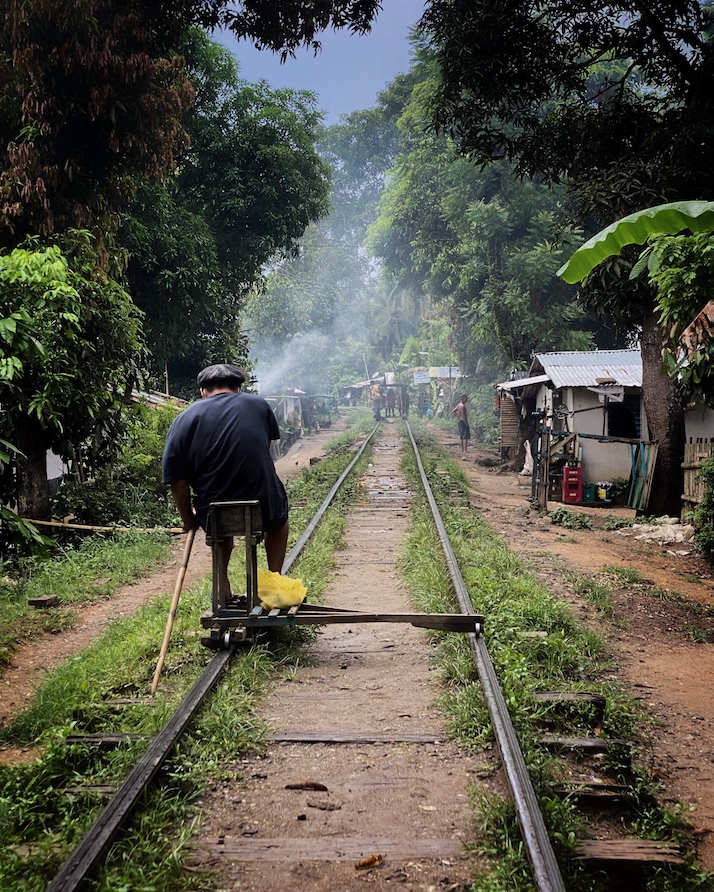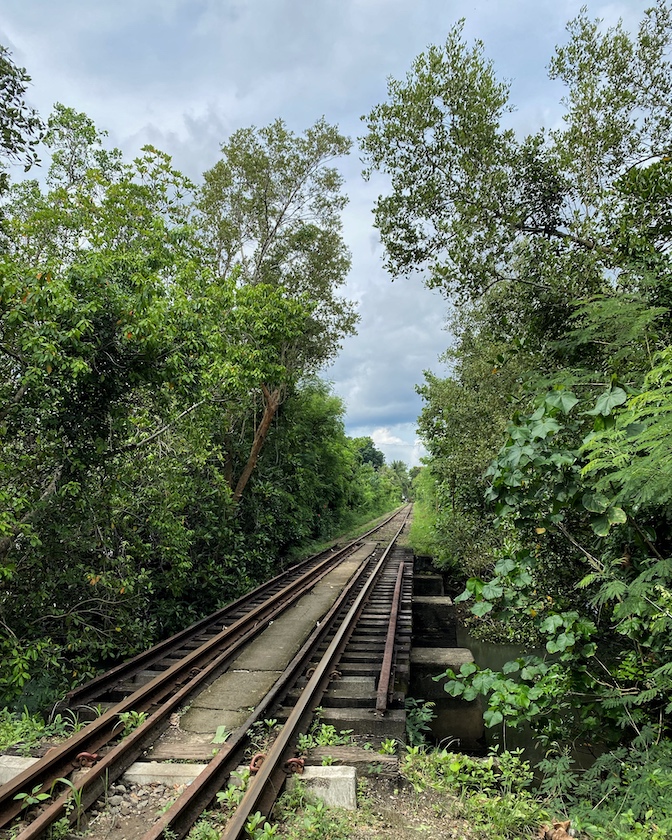
There is something magical about walking beside the railroad at San Jose, on a crisp summer morning. An ironic silence wraps over and under the tracks, amplified by the thin fog that hazes metal, stone, and wood. At first, you won’t see a single soul walking here at this time of the day. The narrow concrete road beside the tracks is fair game for any solitary saunterer. And yet—and you only get this once you’ve stayed here for at least a couple of days—you know that any minute now, a noisy trolley, which locals call “skates,” would appear. You anticipate its arrival, and this dance between silence and anticipation creates that magic.
The trolley could come either from behind or in front of you. Only the squeal of metal announces the arrival of one or two or even three of these humble modes of transportation. On Sundays, expect many of them, mostly carrying families visiting the resorts along Lopez Bay. But some would also carry hollow blocks, gallons of water, or tubs full of fish. When several of them are about to occupy a specific segment of the railroad, you will witness an interesting theatre of bigayan (literally, “giving way”), a stronger flavor of what you would experience when riding the more popular jeep.

Inside the jeep, especially in the Tagalog regions where drivers are without conductors, anyone who rides these public utility vehicles is expected to observe two main rules: (1) Let seniors and people with disabilities occupy the seats nearest the entrance and (2) help the driver collect the fare from other passengers by receiving the money, reaching out, and handing it over to a passenger nearer the driver. You are expected to perform this last rule, even if the passenger paying the fare hands their money over to you without saying “please” or “thank you.” It is a felt rule (pakiramdaman), which Westerners or even other Asians visiting the country and riding the jeep for the first time will never fully understand. And yet, it reflects one of the deepest cultural values Filipinos share—bigayan—a value that is, admittedly, on a decline as newer, more individualistic values challenge it. There are other rules inside the jeep, like women should never sabit or hold on to the handrails at the entrance of the jeep, so one can ride without sitting. Sabit usually happens when passengers are desperate to go home, and jeeps are already scarce. It’s traditionally taboo to see women, especially in a skirt, hanging behind jeeps. Men inside are expected to trade seats with women. But these rules are already being broken or are seldom applied.
In abandoned railroads, such as this in San Jose, trolleys are king, and bigayan takes on a more complex and interesting personality. Only a single trolley could use a stretch of the railroad at any time. This means that if two, three, or even four trolleys meet at a section of the railroad, only one can use the tracks first, and everyone else will wait for their turn. This constraint triggers a swift but beautiful display of bigayan, facilitated not with words but with pakiramdaman. Every single trolley driver knows these felt rules. They know if they need to give way or if they hold the right to use the rails first, and the decision-making happens in about three to five seconds. Once a decision has been made, passengers stand up, get off the trolley, move to the concrete road beside the rails, then the driver carries the trolley (thankfully, it is mostly wood) and parks it on the side. Boom. Boom. Boom. One after another, lego pieces fall beautifully into place.
The felt rules that make such a display of pakikipagkapwa (fellowship) possible are as follows:
- More people trump fewer people. The trolley with the least number of people in it should give way to trolleys with more people.
- More baggage trump fewer baggage. Even if there are fewer people in a trolley, if the trolley contains more baggage, the trolley with people with no or less baggage will give way.
- Heavier and fragile baggage trump normal baggage. Trolleys with baggage that are hard to carry or are fragile (e.g., sacks of rice, gallons of water, hallow blocks, etc.) should pass first.
- More trolleys in one direction trump fewer trolleys in the opposite direction. Multiple trolleys going in the same direction should pass first, and a single or fewer trolleys going in the opposite direction should give way, except if they contain baggage mentioned in rule 3.
Ideally, the driver who ought to give way has to make a judgment call while his trolley is still reasonably far from the trolley who is entitled to first use the rails. This prompt decision prevents waste of time and signals other trolley drivers that he knows the rules. If the driver makes a very late judgment call, the other drivers will let him know.
This morning, there were no trolleys on this segment of the rails in San Jose. Only cold air runs over the immovable metals. After crossing the bridge, I saw a trail on my right, which led to several fishponds. A white dog appeared behind me and entered the path, walking briskly over soft mud.
Nothing was happening on the rails of San Jose.
So, I entered the trail and followed the dog.